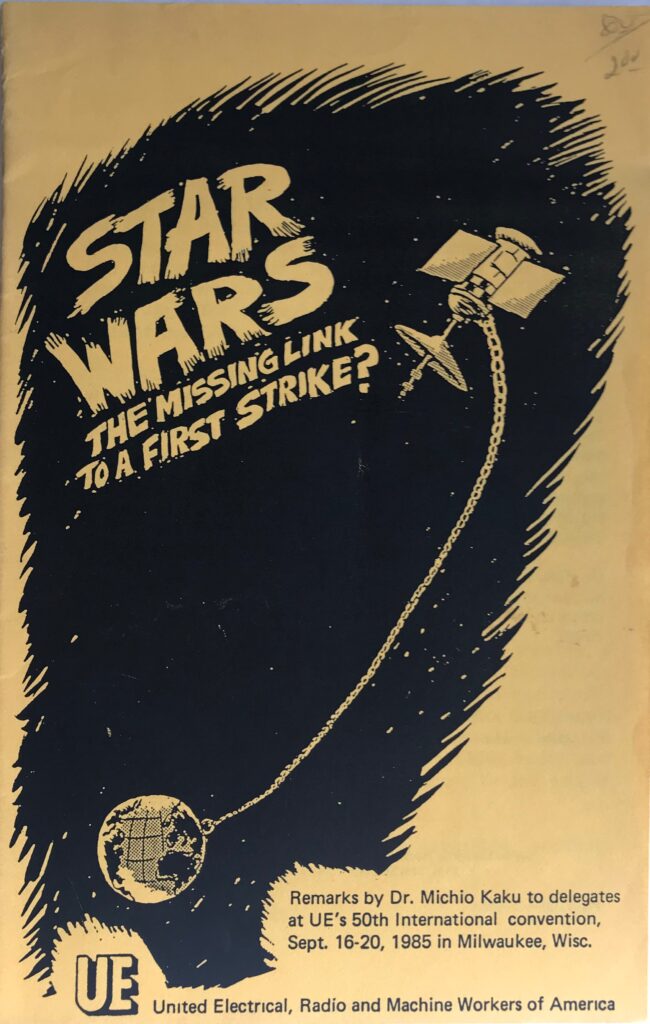Contributed by Anne Bahde, Rare Books and History of Science Librarian
SCARC is delighted to announce that the Robert Dalton Harris, Jr. Collection of Atomic Age Ephemera is now open to researchers.
Carefully collected over three decades, this collection was one of the largest collections on American nuclear history in private hands before coming to OSU in 2017. Collector Robert Dalton Harris, Jr. and his partner Diane DeBlois are authors, editors, historians, independent scholars, and long-time proprietors of aGatherin’, a business that deals in ephemera and original source materials. They began building a collection of materials from the era in the early 1980s, and added books, pieces of ephemera, manuscript collections, and artifacts gradually over decades.

Items involving atomic themes, including Christmas wrapping paper, candy wrappers, and restaurant menus. ID: undated.097
The materials of the collection span over a century of nuclear science and history. Together, these items tell the story of the Atomic Age from every possible angle, capturing the hopes and fears of the world’s citizens as they grappled with the promises and dangers posed by atomic discoveries, both in the United States and internationally.
The Harris Collection of the Atomic Age is in three parts. Part 1 is comprised of nearly 30 separate manuscript and archival collections from individuals who were associated in some way with the nuclear era, including Leo Szilard, Norman Hilberry, Joseph Dietrich, and Peter Skinner. The collection also includes rich collections around the concept of imminent danger or disaster, including the Y2K scare and the fable of Chicken Little. These collections will be processed individually in the coming years. The first of these, the Anne Frewerd Scrapbook, is an exciting first-hand look at a young woman’s life at Los Alamos during the Manhattan Project and will be released soon.
Part 2, Books, is composed of nearly 1,000 published print items, again covering a multitude of nuclear angles and issues and dating from the late 19th century to the early 21st century. Print items include both books and magazines/journals. Cataloging for monograph and serial publications from the Harris Collection of the Atomic Age is ongoing, and research access to these titles is limited until cataloging is finished.

Remarks by Dr. Michio Kaku at UE’s 50th International Convention, Sept 16-20, 1985. ID: 1985.003
Part 3, Ephemera, is the part of the collection now open for researchers. (This previous post explores the definition of ephemera using materials from the collection.) In this collection , the story of the Atomic Age is told through nearly 50 different material types. The majority of items are typical ephemera formats such as newspapers, pamphlets, booklets, brochures, leaflets, flyers, posters, and postcards. Additional formats in the collection include stamps, promotional materials and advertisements, newsletters, instructional materials, conference materials, government documents, calendars, stickers, stamps and envelopes, original art, sheet music, and artifacts.
The Harris materials join existing collections on nuclear history in SCARC, and add considerable depth to a number of nuclear subjects already covered in those collections. The Harris materials also establish sub-strengths that did not yet exist in our collections. Below, and in the next post, we will explore a few of those areas and the research topics across many disciplines these materials can support.
Many materials prior to 1945 deal with early scientific advances and the therapeutic radium craze, documented through promotional materials, testimonials, and advertisements. Prior to the Harris acquisition, SCARC collections were somewhat sparse on this crucial era of nuclear history. The Ephemera Collection adds a number of items, and additional titles wait to be cataloged. These materials can support a wide variety of research topics around radium use in health, science, and culture.
Photographs, scrapbooks, and newspapers from Manhattan Project sites reflect the development of the atomic bomb and the relationships between government, scientists, and citizens during the war. The Harris Ephemera collection has particular strength in the early American response to news of the atomic bomb. This response is documented through over 75 pieces produced in the immediate days and months after the United States destroyed Hiroshima and Nagasaki. The large set of newspapers in this section, particularly the rare newspapers from Hanford and Oak Ridge announcing and discussing the atomic bomb, are a notable highlight of the collection.
Tensions around international control of atomic energy in the years just following the war are represented through offprints, reports, and speeches. Growing anxiety at the start of the Cold War and calls for peace from individuals and organizations can be seen in pamphlets, newsletters, and article reprints. One very rare item describes the Atomic Bomb Casualty Commission and its mission in Japanese for victims of the Hiroshima bombing.
Civil defense is a primary concentration of the collection, and a number of handbooks, manuals, training materials, and survival guides dominate the collection from 1950 to 1965. The Harris materials deepen this existing concentration for our collections and provide exciting new examples of civil defense ephemera, including a fallout shelter sign and other artifacts. These examples with others across our collections can support a wide range of research into this tense period of American history.
The final post in this series will continue to explore the rich Harris Collection, including materials relating to testing, fallout, public engagement with nuclear issues, education, nuclear industries, nuclear power, nuclear disasters, and anti-nuclear activism. The Harris Collection of Atomic Age Ephemera can be now consulted by appointment in SCARC’s reading room.























